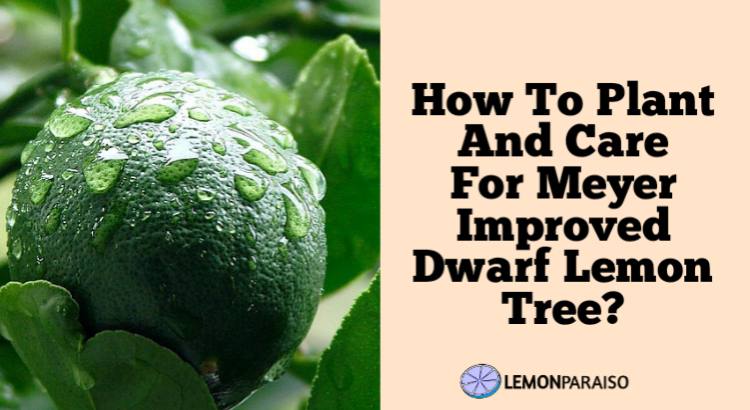Indoor Dwarf Lemon Tree (Care Guide)

Indoor dwarf lemon trees are a popular and rewarding fruit tree to grow in small spaces such as apartments or homes with limited outdoor space. These compact trees are known for their fragrant blossoms, glossy foliage, and deliciously tart fruits, which can be harvested year-round.
They are easy to care for and can be grown in containers, making them an ideal choice for anyone who loves fresh lemons but doesn’t have access to an outdoor garden.
How To Care For Indoor Dwarf Lemon Tree?
Caring for an indoor dwarf lemon tree is relatively easy, as long as you provide the right conditions. First, ensure the tree is in a well-draining pot with drainage holes to prevent root rot. Maintain a consistent temperature between 55 and 85 degrees Fahrenheit, and avoid placing the tree near drafts or heating vents.
Make sure to regularly mist the leaves with water to maintain humidity, which is essential for the tree’s health. Rotate the tree every few weeks to promote even growth, and remove any fallen leaves or debris to prevent disease.
Can Indoor Dwarf Lemon Trees Produce Fruit?
Indoor dwarf lemon trees can indeed produce fruit, given the proper care and environment. These trees will typically begin to bloom with fragrant flowers, which will later develop into fruit.
To ensure fruit production, you can hand-pollinate the flowers with a small paintbrush or cotton swab, gently transferring pollen from one flower to another.
Providing adequate sunlight and proper nutrients will also help promote fruiting. Keep in mind that the tree may take a few years to start producing fruit, and fruit yield may be smaller compared to trees grown outdoors.
What Is The Best Soil For Indoor Dwarf Lemon Trees?
The best soil for indoor dwarf lemon trees is a well-draining, slightly acidic mix. A good option is a blend of equal parts potting soil, peat moss, and perlite or sand.
This mix will provide the appropriate drainage, aeration, and nutrients for the tree, as well as help maintain the ideal pH level of 6.0 to 6.5. You can also add a slow-release citrus-specific fertilizer to the soil mix to ensure your tree has all the essential nutrients it needs to thrive.
How Often Should I Water My Indoor Dwarf Lemon Tree?
Watering your indoor dwarf lemon tree is crucial for its health, but overwatering can lead to root rot. Generally, you should water the tree when the top inch of soil feels dry to the touch.
This can mean watering once a week or every few days, depending on the size of the pot and the environment. Be sure to use a well-draining pot to prevent waterlogged roots.
Additionally, watering with room temperature water can help prevent shocking the tree’s root system.
How Much Sunlight Does An Indoor Dwarf Lemon Tree Need?
An indoor dwarf lemon tree requires plenty of sunlight to grow and produce fruit. Position the tree in a spot that receives at least 6 to 8 hours of bright, indirect sunlight daily, such as near a south-facing window.
If your home does not receive enough natural light, you can supplement with a grow light or fluorescent light to provide the necessary light levels. Make sure to rotate your tree every few weeks to ensure even growth and prevent legginess.
How To Prune An Indoor Dwarf Lemon Tree?
Pruning an indoor dwarf lemon tree is essential for maintaining its shape and promoting healthy growth. To prune, remove any dead or damaged branches, as well as any that cross or rub against each other.
Trim back any overly long or vigorous branches to maintain a balanced shape. Prune any branches growing towards the center of the tree to improve air circulation and prevent disease. The best time to prune is during the tree’s dormant period, typically in late winter or early spring before new growth begins.
How To Fertilize Indoor Dwarf Lemon Trees?
Fertilizing indoor dwarf lemon trees is important for their overall health and fruit production. Use a slow-release, citrus-specific fertilizer that is high in nitrogen, potassium, and phosphorus. Follow the manufacturer’s instructions for application rates, typically every 2 to 3 months.
Make sure to water the tree thoroughly after applying fertilizer to help the nutrients reach the roots. Additionally, supplementing with micronutrients, such as iron, zinc, and manganese, can be beneficial for your tree’s health.
How To Prevent Pests And Diseases In Indoor Dwarf Lemon Trees?
Preventing pests and diseases in indoor dwarf lemon trees involves a combination of proper care and vigilance. Maintain a clean growing environment by removing fallen leaves and debris, and inspect your tree regularly for signs of pests or disease.
Common pests include aphids, spider mites, and scale insects. If you notice any pests, treat them with insecticidal soap or neem oil, following the manufacturer’s instructions.
To prevent diseases, ensure proper air circulation around the tree, avoid overwatering, and prune any dead or damaged branches. Quarantine any new plants before introducing them to your indoor garden to prevent the spread of pests and diseases.
How Long Does It Take For Indoor Dwarf Lemon Trees To Bear Fruit?
The time it takes for indoor dwarf lemon trees to bear fruit can vary depending on the tree’s age and overall care. Generally, it takes between 2 to 3 years for a grafted dwarf lemon tree to begin producing fruit, while a tree grown from seed may take up to 5 to 7 years.
Providing adequate sunlight, proper nutrients, and consistent care will help your tree reach its fruiting potential more quickly. Keep in mind that patience is key, as fruit production can be slower for indoor trees compared to those grown outdoors.
Can Indoor Dwarf Lemon Trees Be Grown From Seeds?
Indoor dwarf lemon trees can be grown from seeds, although it’s important to note that trees grown from seeds may not produce fruit identical to the parent plant. To grow a dwarf lemon tree from seed, remove the seeds from a ripe lemon, rinse them thoroughly, and let them dry for a day or two.
Plant the seeds in a well-draining, slightly acidic soil mix, and keep the soil consistently moist. Provide the seedlings with plenty of sunlight and warmth, transplanting them to larger pots as they grow. Although growing a tree from seed can be rewarding, purchasing a grafted dwarf lemon tree from a nursery can save time and ensure fruit production.





